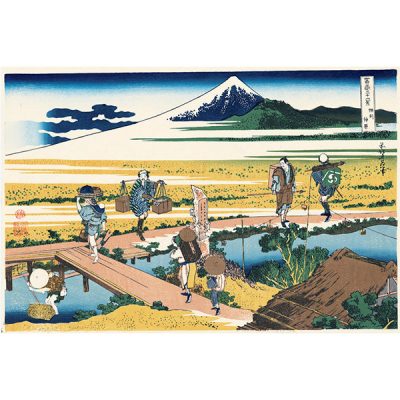Hokusai
Nakahara in Sagami Province by Hokusai
In the Edo period in which the artist produced much of his work Nakahara was the point at which pilgrims would leave the Tokaido Highway – stepping onto the Oyama Road en route to the sacred Mount Oyama. Paying homage to a rock at the mountain’s summit called Qyama Sekison to seek crop yielding rains, pilgrims were only able to walk the route during the autumn season in the sixth and seventh months of the year.
In this evocative scene the viewer is presented with a busy river crossing where travellers along the route and local Sagami people converge. In the far left corner is a fisherman hunting in the shallows as two pilgrims pass to his right onto the bridge – the roadside carving of the traditional god Fudo marking the route to Oyama behind them. Ahead of the pair is a woman with a baby strapped to her back in contemporary fashion, while also being weighed down with tools and other items of labour.
In the middle ground, along the Tokaido Highway, the bustle of the day develops further with a local farmer hoping to sell seeds to the pilgrims heading across the bridge. Ahead of him, looking longingly at the farmer’s wares, is another pilgrim hoping to beg a meal and drink, perhaps. He is turned away from another local seemingly laden with supplies.
It is in the background where the sacred mountain of Fuji sits – typically from Hokusai’s artworks located front and centre though seemingly primary not the subject matter. The shape of Fuji is echoed in the fore-right of the image through the roof of a shack to give further resonance and balance to the piece. Printed in one of Hokusai’s preferred methods of colour woodblock on paper the limited palette is easy on the eyes inviting closer study.
Katsushika Hokusai (c.1769 to 1849) is most famous for his world-renowned The Great Wave off Kanagawa. That work, often reproduced on anything from tea towels to tattoos, may well be an icon but it is only one in the artist’s study, Thirty-six Views of Mount Fuji. The piece here, Nakahara in Sagami Province, comprises one of these pieces.
